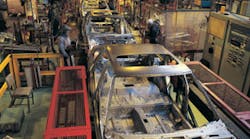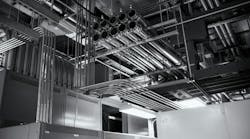For the last few years, “outsourcing” has been the buzzword in the plant maintenance world, and the numbers prove it. In 2004, consulting firm D.F. Blumberg Associates, Willow Grove, Pa., estimated that servicing industrial equipment, a $69 billion business in 2000, was expected to grow to $99 billion by 2005 — an annual growth rate of 7.5%. Jim Rogers, director, RWD Technologies, Baltimore, says that U.S. manufacturers alone spent $7.8 billion on outsourcing in 2001, and that's expected to spike to $12 billion in 2006. In 2005, 24% to 45% of maintenance activities were outsourced, compared to only 15% to 20% in 2000.
From servicing turbine engines to moving entire lines to new facilities, plant managers have followed upper management directives to lower costs and cut downtime by handing over tasks labeled “non-core” to outside vendors. The bulk of these tasks go to firms — typically subcontractors — specializing in industrial maintenance. “What do plants want to do?” asks Rogers. “Produce what they do for a living, or run a maintenance crew?”
Rogers says that when it comes to manufacturing operations, 60% of the organization accounts for internal service and production, while maintenance accounts for up to 40% of the plant overhead. “Literally, you're running two businesses,” he explains. “That's why a manufacturer would be attracted to outsourcing.”
Labor pains. In recent years, lowering costs through outsourcing focused on the labor component of maintenance. Outsourcing has come to mean laying off entire maintenance crews — which might then be rehired by the subcontractor at lower wages, no benefits, and less steady work. In more densely populated areas with a larger pool of ready, skilled labor, however, your staff would most likely be replaced with different workers altogether. In this all-or-nothing approach to plant maintenance, operating costs may be temporarily lowered — after an initial maintenance increase in the short term — but at what price?
There can be serious repercussions to losing the knowledge experienced, qualified in-house staff have acquired over years of working with particular equipment and machines. “The risk is a loss in tribal knowledge,” Rogers says. “You let the person go who knows how to kick the machine in the right spot and get it running, then what do you do?”
There is also the inevitable rancor after a mass layoff. “Outsourcing can be very painful for companies,” says Mike Cowley, president, CE Maintenance Solutions LLC, Buffalo Junction, Va. “Outsourcers promise savings, and what they do is cut numbers of staff. It's very difficult for an outsourcer to do it cheaper because the other factor to consider is that the outsourcer has to make a profit — anywhere from 7% to 10%, depending on the type of maintenance — so you'll add 15% to 20% margins on top of the cost to perform your maintenance. So it's not something to jump into lightly.”
A better approach to managing maintenance might be “out-tasking,” contracting out specific specialized tasks, or even assessing maintenance planning and processes, picking and choosing from different plans — such as hiring a maintenance consultant to advise your current manager and staff or hiring contract managers to manage plant maintenance and facility engineering activities — before determining that the solution can be found in cutting labor.
Filling the gap. There's no shortage of electrical contractors specializing in industrial maintenance who are willing to perform the tasks that full-time plant maintenance staffs don't have the time or skills for. “I wish I did nothing but maintenance work,” says Bob Judd, owner, Arc Electric, West Hazleton, Pa.
The family-owned business got its start in new construction 30 years ago, but through relationships with customers has established a plant maintenance business, working with companies in its region, such as Hershey Chocolate USA and Quebecor Printing.
Lately, because of the general electrical labor shortage or the cuts made due to outsourcing, Judd finds that most plants don't have enough full-time staff members to maintain their facilities. “Unfortunately, not a lot of people are attracted to being in maintenance in these plants, so two things are happening,” he says. “They're short on manpower, and they have to pay more if they want to get good quality people. So they depend more and more on the electrical contractor to support their efforts.”
Judd's maintenance crew — around 15 out of 30 full-time employees in the firm — works for plants by putting in new lines or modifying existing ones for new products. Arc Electric also helps move entire product systems to new locations. “They simply don't have the maintenance people to carry that off because they're busy maintaining the equipment they already have,” Judd says. “We work on anything that has to do with the physical part of the machinery.”
Currently, Arc Electric doesn't have any formal contracts with plants; instead it works from existing relationships forged through new construction work. “When the construction job is finished, they have us come back and do other stuff for them,” Judd says. “We support their maintenance people or provide maintenance if they don't have a staff.”
The company works on an on-call basis and in a T&M (time and materials) mode. The firm provides the client with an estimate and then receives a purchase order for the work. “We'll come in and give them an estimate, usually like a ‘not to exceed’ price, that they can use to get the purchase order with, and then we'll do the job for the most part, time and material, not to exceed that number.”
There is an element of risk in working without a contract, but according to Judd, it works out for the most part, if only in repeat business. “We're the ones at risk if it doesn't come in under what we say it's going to be,” he says. “Conceivably, we could be doing it at our expense. We sort of hold our hands to the fire to have a good number. Usually, the customer asks us to do other things. So the price may go up, but it's only because they've asked us to do more work. Sometimes it's not clear what their wants and needs are, so we're only giving it our best guesstimate of what it's going to cost, and then we usually fill in the blanks later.”
Because of the support role Arc Electric plays in maintenance work, Judd says he hasn't noticed any resentment from the plants' maintenance staff. “From what I've noticed, there hasn't been a whole lot of feelings like we're trying to take their jobs,” he says. “They're busy doing what they're supposed to be doing, which is keeping those machines running so they can continue to produce a product. They don't necessarily have the time or even the expertise to do the things that we do, nor do they have the equipment to do it with. They generally don't have big pipe benders and wire pullers and threaders because they wouldn't do that kind of work. So we work in harmony.”
An added benefit of hiring a contractor well versed in plant maintenance is that it can help in the design of maintenance procedures. “The plant maintenance people don't really know different ways to save the customer money,” Judd says. “We look at it a little differently. That's the value that we bring to the job. We'll look at something and come up with the most cost-effective way to do it versus the ‘don't really care how much it costs, just do it’ attitude.”
All the right reasons. That rethinking of maintenance procedures may be exactly what some plants need. “Quite often, if you're thinking about outsourcing, you're probably not operating very efficiently to start with,” Cowley says. “The first thing I always ask is, ‘Why do you want to outsource?’ I try to get to the root cause of why they're even mentioning that word. I always ask them why they want to outsource, and quite often it comes to, ‘Well, our fellows are inefficient, and they're costing us a lot of money.’ A lot of times I respond back, ‘Why don't you fix the organization that you have now?’”
A study by the Plano, Texas-based consulting firm A.T. Kearney backs up Cowley's suspicion, noting that many outsourcing services are hired for the wrong reasons. More than 80% of the companies in the study reported outsourcing to reduce operating costs, reduce capital investment, and concentrate on their core business. Of these companies with revenue-related goals, the majority reported failure to meet them. “I think a lot of people go after outsourcing because after they read a few business magazines, they assume it's a way to save money,” Cowley says. “A lot of these decisions come down from a high level of management that say, ‘We can save 5% on our total labor and our benefits if we go to an outsourcing contractor.’”
According to the Kearney study, less than half of the participating companies cited increased speed to market, improved quality, and faster customer response time as their reason for outsourcing. However, when companies use these objectives as their reasons for outsourcing, they're usually more successful. One way to determine the extent of outsourcing or out-tasking the plant actually needs is to ask a few questions. Are there large variations in the workload for your electricians? Are you expecting a temporary, scheduled increase in their workload that may require additional workers? Are the activities labeled as “non-core” actually “core” items? Are there special skills or tools needed for a task that would be too costly to train for or purchase?
Also, the goals and objectives behind the decision to outsource should be clear and consistently communicated to the current staff. One common misperception of outsourcing is that the motive behind it is a poorly performing workforce. If the outsourcing will change current employment status, the human resources department should be included in the implementation and transition team to explain the benefit plans, salary structures, and work schedules. It's important to include employees who may now report to the plant as contract maintenance crew in company communications, activities, and meetings. “You've got to reorganize your organization so it's efficient, and that's where people really don't know how to do it,” Cowley says. “I think that's why they tend to go to outsourcing — because they really don't know where to start. With the proper people and the proper financing, there's nothing that an outsourcer can do cheaper than you can do in-house, unless it's a specialty. If you get with a good outsourcer, there could be some savings through better processes, better equipment, and better technology.”
Information please. Most industry consultants are in agreement that when it comes to specialized tasks requiring specific knowledge or specific tools, outsourcing may make performing the task easier. “Companies don't want to do vent maintenance on electrical turbines because of the complexities, so they outsource that certain area,” Rogers says.
When outsourcing complicated procedures or work on intricate machinery, the reliance on information systems is increased. “The evolution of outsourcing lies in how you provide that knowledge and those tools of your organization so the job doesn't slow down,” Rogers says. “The complexity around information and how that information is going to be delivered is parallel to the trend of maintenance being outsourced. One can't happen without the other.”
In fact, one current trend in outsourcing is to separate the processes from the labor, so plant managers can pick and choose which stage to outsource. According to Rogers, there are three areas that can be outsourced: maintenance planning, which is scheduling, work order administration, and the fine tuning of the maintenance plan; the maintenance service itself, which consists of the actual work; and the maintenance engineering, comprising who's doing the procedures, the work orders, the equipment reliability, the required safety, tools, and documentation, and the print updating.
For a plant to be successful in outsourcing its processes, along with labor and engineering, it must provide certain information to the contractor. First, the contractor must have access to functional operational procedures. In other words, if an outside vendor comes in to do maintenance, it's going to have to have procedures on how to operate the equipment. Second, contractors need a clear set of maintenance procedures, including a list of tools and materials. This should be provided before the contractor is onsite. Third, the contractor needs access to maintenance histories. Fourth, documented safety procedures will have to be delivered to the contractor, as well as equipment reliability information. Fifth, depending on the complexity of equipment, contractors may require point-of-service training. For example, safety, quality training, or even specialty training on the machine — e.g., a valve may have to be turned off in order to conduct this type of maintenance. Finally, the plant maintenance staff must still track training history, at the bare minimum in order to comply with OSHA regulations.
Using electronic support services may ease the burden of these requirements. “The old paper-based job work order is going to become obsolete,” Rogers says.
Soon, job orders will be received via electronic devices, such as PDAs. “In that PDA you'll have links to all required documentation and tools required to do the job so the maintenance can show up prepared and get the job done quickly.”
Risking it. Whether working through a contract or a purchase order, the information and requirements of the outsourced tasks should be clear to both parties. “A risk is the unknown maintenance person or unknown electrical contractor,” Rogers says. “It can be anybody if you're outsourcing it. Are they safe? Do they have the skills? Will they show up with the required materials and tools to do the job? Or will everything slow down because they'll show up and evaluate a job and have to come back to do the job?”
Consultants advise plants to make sure they legally transfer the company's liability to the contractor performing work at the facility. To transfer the risk, the plant should be named as an “additional named insured” on contractor's insurance policy. This can be verified by obtaining a current certificate of insurance from the contractor.
Additionally, both the plant and the contractor should be up to date on their OSHA compliance liability. The contractor's employees should be informed of the existence, location, and nature of any chemicals to which they may be exposed, lockout/tagout should be handled by both the facility and outside contractor, as well as working out ways for confined space entry and process safety management.
Plants are responsible for exercising due diligence to ensure an outside contractor is in compliance with their own OSHA compliance obligations, much like the relationship between general contractor and subcontractor on multi-employer worksites.
Whether you're outsourcing entire maintenance plans or out-tasking specialized duties, the key to success is a close arrangement between the plant crew and contract workers. According to Rogers, the best way to make the relationship work is to foster a sense of co-ownership. “You want to make the maintenance people or outsource contractor a part of your overall risk in dollars,” he says.
Some consultants recommend that plant owners make up a contract offering an incentive to the contractor firm for a job well done. “The owner has to want the contractor to make money,” Cowley says. “If you have this feeling that he's going to screw you, it's not going to be a good relationship. It really takes some good personalities on both sides to make any kind of outsourcing successful.”
Sidebar: The Old College Try
Manufacturers may be able to learn a lesson in flexibility from the plant maintenance crews at some colleges and universities. While decidedly not the “core” business, facilities maintenance tasks are usually handled at most institutions by a full-time staff that performs regular maintenance duties yet hires out special projects to local contractors.
With 14 full-time staff members, including one electrician, Keith Smith, plant manager at Polk Community College, Winter Haven, Fla., manages facilities for two campuses. For the projects he doesn't have enough staff to maintain, he hires contractors. “For the most part, we do the electrical in-house,” he says. “We outsource to local contractors on larger projects, renovations.”
Other projects outsourced to contractors include the chillers at the school's physical plant. “Once a month they do the service on the chillers, check all fluid levels, and take the readings,” Smith says. “They're on call 24/7 for any emergency repairs, and then their scope for parts plus labor.”
The current vendor works under a three-year contract with the option to renew for an additional two.




